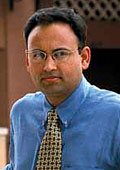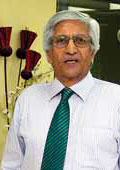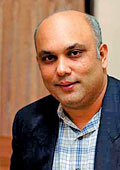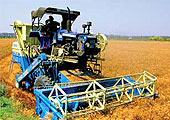 |
The Medury family
When Ram Kalyan Kumar Medury, 32, worked the numbers for his
now two-and-a-half-year-old daughter Ritsika's education,
he figured it would cost him almost Rs 70 lakh 20 years from
now. So the family is earnestly building wealth for their
kid by saving 25-30 per cent of their income, of which 60
per cent goes into long-term equity funds and the rest into
a combination of debt, ULIPs and equity |
The Medurys began investing for
their child a couple of months after the birth of Ritsika, their
only daughter, now two-and-a-half years old. When he did the math,
Ram Kalyan Kumar Medury, 32, Group Project Manager at Infosys-Hyderabad,
came up with numbers that will shape the future of their playschool-going
child and was taken by surprise. "I did some arithmetic a
few months after Ritsika was born and was shocked at the estimate
of the cost of her education in inflation-plus terms. For instance,
an MBA at a leading B-school costing about Rs 15 lakh today would,
at 6 per cent inflation, cost Rs 45 lakh, 20 years from now. Throw
in similar numbers for college education and the total would go
up to almost Rs 70 lakh, and we are not even talking about Ivy
League education abroad," he says.
It's one of life's biggest and all-important investment decisions.
And it does not come cheap. There are bills-and huge amounts-to
be paid at every stage of life, whether it's pre-school, school,
college education and professional courses or marriage. Then you
may want to do more: you may also want to leave your child with
more than enough for the future and set her up for life-leave
her with a legacy to cherish.
Goal Seek
Indeed, most parents find themselves in the
familiar spot-where to begin? But there's nothing like setting
targets for your kids or milestones and then working to achieve
them. "Determine your broad long-term objectives, short-
and middle-term needs and investments you can make keeping in
mind your cash flow requirements. Begin by covering against risks
and proceed with asset allocation that will encompass your main
objective: create wealth for your kids," says Viraj Ghatlia,
Head (Financial Planning), IL&FS Investsmart.
Determine where and how much your kid will
require for his future. Says Rohit Sarin, Founder Partner, Client
Associates, a private wealth management firm: "Every couple
must set specific milestones and then resolve to meet them through
savings. It's easy to assess your performance midway and make
adjustments-such as revising your milestone, increasing your savings,
or pushing your horizon farther."
| THE DIFFERENT STAGES
OF GROWTH |
SCHOOL (Years:
5-15)
Cost: Rs 5-7 lakh; Yearly cost: Rs 70,000
Portfolio: Equally in stocks and debt
COLLEGE (Years: 15-20)
Cost today: Rs 7 lakh; Cost after 10 years: Rs 12.5
lakh
Yearly investment: Rs 60,000
Portfolio: 70 per cent in stocks
PROFESSIONAL OR MBA COURSES (Years:
20-25)
Cost today: Rs 15 lakh; Cost after 15 years: Rs 35
lakh
Yearly investment: Rs 75,000; Portfolio: 95 per cent
in stocks
MARRIAGE (Years: 25-27)
Cost today: Rs 7 lakh; Cost after 20 years: Rs 22
lakh
Yearly investment: Rs 22,000
Portfolio: 95 per cent in stocks
Illustrative example for a five-year-old
Inflation: 6 per cent
Rate of return: 15 per cent
Approximations and indicative costs
|
 |
The Biswas family
Agnimitra, 36, and Sarmistha, 34, have distinguished investment
plans into two parts-a protection plan and a wealth building
plan. A Smartkid plan provides a part of their child's monetary
requirements at different milestones. A wealth building plan
relies on mutual funds largely through systematic investments.
Six-year-old Soham is the nominee of all their investments
|
Investing enough for their kids' higher education
is their number one goal and Chennai-based B. Sriram, Zonal Manager
(Finance), Spencer's Retail, is doing just that by accumulating
assets that will be really useful for his children-eight-year-old
son Shreyas and 18-month-old daughter Sandhyaa. "We are from
a middle-income group and are beginning to see surplus funds only
recently. I hope to accumulate at least Rs 10-12 lakh for each
of my children for their higher education," he says.
Build a Solid Foundation
A bulk of children's financial requirements,
thankfully, comes at a later stage. So, start with equity. "If
your objective is to create wealth for your kids, your portfolio
will have to be skewed towards equity. The equity part can compose
of 60-80 per cent of equity-based mutual funds and 40-20 per cent
direct investment in stocks. I would recommend diversified equity
funds and the rest blue-chip large-cap stocks of companies that
have excellent prospects," says Amar Pandit, a Mumbai-based
Certified Financial Planner of My Financial Advisor. "For
most working class couples, direct investment in stock market
is a riskier proposition than investing in mutual funds and so
I would recommend well-rated MFs," says Rajiv D. Bajaj, Managing
Director, Bajaj Capital.
Equity investing also comes with its own
share of risks. "Building an investment portfolio depends
upon your willingness to take risks, ability to take risks and
the need to take risks. For a relatively young couple wishing
to build wealth for their children, equity comes across as an
asset class with highest returns.
For the debt part of the portfolio, Pandit
recommends investments in PPF, which gives 8.5 per cent tax-free
return. "The fixed maturity plans (FMPs), which give 9-10
per cent, are also not bad in the current interest scenario.
THE ROAD AHEAD
Four ways to invest for your kids. |
| Equity Power: The longer your goals,
the more you invest in equity or equity MFs, which select
stocks for you. For direct investors, it's prudent to stick
to sound and growing blue chips. Equities compound wealth
the fastest
Balance with Debt: Add on debt to balance your
portfolio. If your goals such as, say, college entrance
is nearing, it's prudent to shift to debt to balance your
payments. Steady investments such as government savings
can be used
Gold's a Shield: Gold has not been a wealth builder,
but it acts as a hedge in the long-term against global currency
risks. For the long haul, a bit of gold is no harm, as it
can counter any global reaction
Real Estate is Steady: If you want to give a gift
to your child when she's older, go for one. Real estate
normally appreciates steadily and gives inflation-beating
returns
|
Bajaj says that couples should seek to build
a portfolio aggressively tilted towards equity, which will gradually
shift more towards debt over the years, noting that asset allocation
is a dynamic, not a static, process. As your child needs, say,
entrance fee to join a B-school, you can gradually shift from
equity to debt.
 |
 |
 |
|
Amar Pandit
CFP/
My Financial Advisor
"If your objective is to
create wealth for your kids, your portfolio will have to
be skewed towards equity"
|
Viraj Ghatlia
Head (Financial Planning)/IL&FS Investsmart
"Determine your needs and investments
you can make keeping in mind your cash flow requirements"
|
Rohit Sarin
Founder
Partner/ Client Associates
"Every couple must set specific
milestones and
then resolve to meet them through savings"
|
As for real estate as an investment avenue,
Ghatlia says property is not as liquid as equity and may not work
for a couple wishing to boost their wealth. Agrees Sarin: "For
a typical working class family, as much as 45 per cent of household
savings go into buying a house to live in. There is hardly anything
left to invest in property as investment vehicle considering the
skyrocketing price of real estate."
 |
The Sriram family
The Srirams believe in building real assets for their kids.
B. Sriram, 39, bought a plot and made a small beginning by
investing in small quantities of gold. "I hope to have
Rs 10-12 lakh for each of my children's higher education,"
he says |
For the Srirams, however, property has been
a good investment. A 2,400 sq. ft plot that he bought 18 months
ago near Tambaram, a Chennai suburb, for Rs 3.5 lakh is now worth
Rs 10-12 lakh. It's not a bad idea also to include a bit of gold
in your assets. "You can have gold as 5 per cent of your
portfolio because it is considered a good bet against inflation,
war and global currency risks," says Pandit. Sriram, for
example, plans to collect 350-400 gm of gold for his daughter.
Tune and Fine-tune
Review your portfolio regularly. If it's
not doing well, assess the reasons and rejig it for growth. Your
plans can go for a six if you are not beware of the future shockers-as
your income rises so does your 'lifestyle costs', your debt may
have crossed the reasonable threshold, your health may be taking
a turn for the worse, and the cost of education may be rising
dangerously. "Today, lifestyle inflation is the biggest threat
to your saving and investment potential. An annual review of your
budget can save you from sliding into extravagance. Also important
is regular health check-ups," says Sarin.
Adds Pandit: "Instead of keeping an
expenditure budget, keep a savings budget and stick to it."
-additional reporting by
E. Kumar Sharma, Ritwik Mukherjee and Nitya Varadarajan
Reap A Bumper Harvest
As agri-sector booms, related companies
offer good opportunities for investors.
By Shalini S. Dagar
Investment
gurus such as Jim Rogers saw it coming as early as 1999. Prices
of agri-commodities are soaring in the face of sustained uptick
in global demand and stagnating production. Notwithstanding the
scorching economic growth in India, Indian agriculture is painfully
ambling along at around 2 per cent due to decades of under-investment.
That, however, is changing.
With the policy-makers renewing efforts to
boost agriculture-the last two budgets were agri-focussed-now,
a clutch of companies is poised to capitalise on the coming boom.
Right from companies that provide farming inputs such as seeds
to farming techniques and machinery to those involved in distribution
of farming products-companies in the agri-sector are slowly coming
into the limelight. As the farm income increases, another class
of companies that has traditionally focussed on urban centres
has rapidly increased its penetration in rural India. These are
banks and consumer durable companies. There are many themes playing
out in the agri-sector. (see The Seeds of Growth).
The Base Producers
The first to benefit are direct agri-products
companies. Commodity prices affect the earnings of rice millers,
sugar producers and tea manufacturers. Investment opportunities
abound in this category as the global and domestic demand is expected
to remain strong over the coming years, and prices are expected
to remain reasonably firm. "Strong demand will require a
substantial increase in acreage, which has been virtually unchanged
for decades. Until that happens, agricultural prices are likely
to stay elevated," says Si Kannan, Associate Vice President
of Kotak Commodity Services.
Hence, companies producing agri-based products
are well poised for the future. A case in point is rice and wheat
miller Usher Agro, which listed last year at Rs 9, but zoomed
to Rs 30 levels soon thereafter. The stock thrived on the back
of steady demand for its products by acquirers such as Food Corporation
of India, among others. Besides companies such as REI Agro, krbl,
exporters of the long-grained and aromatic basmati rice, are also
riding the crest of the same wave.
 |
|
"The seeds business is cyclical
but fetches high return on investment"
Harendra Kumar
Head (Research)/ ICICI Direct
|
Sugar is yet another agri-commodity which
is on an upswing. ADBI Capital's agri-analyst Maitali Shah picks
up India's top two sugar producing companies, Bajaj Hindusthan
and Balrampur Chini, along with Dwarikesh Sugar for a long-term
play of four years and more. She cautions though, "sugar
stocks are not in favour just now as off late, sugar industry
is facing a glut." Arun Kejriwal, Director, Kejriwal Research
and Investment Services, however, points out that the long-term
story in sugar will play out more aggressively once India starts
looking seriously at ethanol as an alternate fuel. Ethanol is
a by-product of sugar processing. Brazil has made a significant
move towards using ethanol and that move alone has affected global
sugar prices tremendously.
Besides, companies in the business of food
and solvent extractions are seeing a revival in their fortunes.
Among the many companies, Ruchi Soya and KS Oils-companies into
solvent extraction-also feature high among investors' favourite
stocks.
Indirect Beneficiaries
However, soft commodities apart, there are
many more investment opportunities within the broad agro-theme.
One company that has been in focus is Jain Irrigation. It is the
largest supplier of micro-irrigation equipment in the country.
As the government stresses on increasing the arable land under
irrigation, the company is well poised to take advantage of the
investments coming in new irrigation techniques. Finolex Industries,
KSB Pumps and Kirloskar Brothers, too, fall in the category of
agri-infrastructure companies.
As production techniques are spruced up,
the agri-input sector which provides the much-needed stimulant
to crops is the seeds and the fertiliser sectors. There are a
number of players in this segment-among them Advanta India, which
debuted recently on the stock market, and Monsanto India. "The
seeds business while being cyclical shows high return on investment
once the seeds are launched in the market," says Harendra
Kumar, Head (Research) at ICICI Direct. Kumar points out that
increased corporatisation of agriculture will provide a tremendous
fillip to the seeds business as companies try and improve the
low yields from most crops. Other companies worth considering
are agro-chemical companies such as Rallis India, United Phosphorus
which deal with crop protection chemicals.
Fertiliser companies such as EID Parry, Coromandel
and Godavari Fertilisers or gnfc are good bets as we look into
the future even though they operate in a highly regulated environment
as yet.
Among other equipment producers, tractor
companies also provide a good opportunity as increased mechanisation
of farming results in an increased demand for tractors. M&M
has significant share of this market.
The Fringe Gainers
There are many companies not directly related
to agriculture but thriving nevertheless on the agri-sector. Mahindra
& Mahindra Finance is essentially a play on India's rural
economy with more than 70 per cent of its business coming from
rural and semi-urban areas. Brokerage house SSKI believes that
the "increasing focus on agriculture by the government, corporates
and organised financiers would propel India's rural economy on
to a higher growth trajectory. M&M Finance is ideally placed
to capture this opportunity." ICICI Bank is also aggressively
zooming in on rural markets.
Agriculture contributes about 20 per cent
to the gross domestic product. As of now its capital market exposure
is fairly insignificant. But market observers reckon that the
shift is imminent as agri-sector gains dominance in the coming
years. Says Jaideep Goswami, Head (Research), UTI Mutual Fund:
"As investment picks up in agriculture, the sector will improve
its share of market capitalisation to reflect its importance in
the overall economy."
Get The Accident Cover
An accident protection plan could help
you recuperate or get your family to bounce back in case of the
worst.
By Nitya Varadarajan
 If
there was a way of telling when and where a calamity can strike,
you would avoid it, of course-and you wouldn't need accident insurance
either. But since that's impossible, most people, especially for
on-the-move individuals, personal accident insurance offers a
contingency plan not just against road accidents, but against
seemingly innocuous sounding incidents such as falling off a ladder
or even being whacked by neighbour's cricket ball. If
there was a way of telling when and where a calamity can strike,
you would avoid it, of course-and you wouldn't need accident insurance
either. But since that's impossible, most people, especially for
on-the-move individuals, personal accident insurance offers a
contingency plan not just against road accidents, but against
seemingly innocuous sounding incidents such as falling off a ladder
or even being whacked by neighbour's cricket ball.
In fact, an accident insurance policy covers
your life at three different levels of contingencies-death due
to accident; permanent total disability (total loss of eyesight
or limbs, deafness, paralysis, etc.); permanent partial disability
(loss of vision in one eye, loss of one hand, etc.) and temporary
disability (loss of work due to short-term disability). And they
come in handy, particularly when you have been hit by a shocker
that sets you back financially.
Besides, accident insurance policies come
cheap relative to the risk because accidents are unpredictable.
For a cover of Rs 1,000 sum insured, the premium rates vary between
75 paise and Rs 3.5, depending on the policy you choose. Most
accident insurance polices are valid for a year, but there are
exceptions. Insurers such as ICICI Lombard, for instance, offer
a continuous policy for a term option of three years and five
years, which means renewal does not fall every year, though you
must remember the year it lapses so you can opt afresh for a new
policy.
Accident covers, however, have different
features. But one that offers a combination of death, permanent
total disability and permanent partial disability is your best
option in case you are on the move. Some companies also offer
a 'loss of income compensation' for a temporary partial disability,
but at an additional premium. Some standard policies offer an
additional education benefit for no extra cost-a one-time amount
of Rs 5,000 or Rs 10,000 or a percentage of premium, whichever
is less-for the child that has lost a parent or other costs such
as carriage costs to cremation grounds.
RIDE THE LIFE COVER?
Should you opt for an accident rider on
life? |
»
Don't opt for this, unless you are reluctant to
approach a general insurer separately for the purpose. An
accident insurance rider on a life cover is more expensive
than one taken separately
» Family
covers for accident insurance benefits cannot be tagged to
the cover of a life insurance policy which has a single beneficiary.
Your spouse and children, too, could do with accident covers
» An
accident benefit rider on a life insurance policy will not
have many of the feature variations offered by a general insurer
» Once
a rider lapses (upon its first use), you cannot take another
rider for the next year to the same policy. You can, however,
opt for a general insurance cover
» General
insurers spell out clearly the process involved to make a
claim when the policy is taken, besides there are help desks.
They are equipped to deal with policies that require yearly
renewal |
| |
GO, GET IT
Why an accident cover is a must.
|
»
Accidents can
happen anywhere. If it results in death, the beneficiary will
get a decent sum which is far more than a traditional life
cover
»
There are benefits
in case of total permanent disability-100 per cent of sum
assured is given
»
In case of temporary
disability, some companies cover loss of income for 52-102
weeks
»
There are compensations
for various levels of injuries. A hospital confinement/medical
expense up to a percentage of sum insured is available at
an extra cost, and must be taken |
The amount of compensation, however, varies
depending on the type of disability. In case of death, survivors
get 100 per cent of the sum assured. Besides, total permanent
disabilities are given due consideration by most insurers. "Companies
generally treat total permanent disability as equal to death and
compensate 100 per cent of sum assured," says Vinod Sehgal,
Managing Director, Bajaj Capital Insurance Broking. In case of
semi-disablements, the compensations are usually determined in
percentages. In fact, compensations for partial permanent disability
can go up to 60 per cent-but this really depends on the kind of
disability. Further, Royal Sundaram, for instance, offers 75 per
cent of capital sum for loss of hearing in both ears and 40 per
cent in the case of loss of four fingers and thumb of one hand
or 6 per cent for loss of middle finger.
 |
|
"It is best to opt for a policy
that would have a sum assured of five times the annual salary"
Vinod Sehgal
MD/Bajaj Capital Insurance Broking
|
But there are certain product extensions that
go some way in reducing your financial burden. If you have to
undergo inpatient treatment, you are reimbursed medical expenses
up to a pre-set limit. With medical costs being what they are,
this is a must-opt provision, although you have to furnish medical
bills to settle the claim and it also covers other costs such
as extra nursing, or transportation of attendant to hospital.
Sometimes, insurers offer their own USPs
to the product. Cholamandalam ms allows 'for modification of car
or house' on account of disability up to a maximum of Rs 50,000.
This is for people who may require sudden modifications such as
installing hand brakes in cars or ramps in a house to ease movement.
But how much accident cover do you need?
"It is best to opt for a policy that would have a sum assured
of five times the annual salary," says Sehgal. "Housewives
should be covered for at least 75 per cent of the principal amount,
while children should have 50 per cent cover," he feels.
True. It's your only back-up plan.
NEWS
ROUND-UP
Now, Taxing Forms
Saral has made way for the new ITR forms.
What's changed?
By Krishna Gopalan
 |
"The new way of filing
means that the individual taxpayer is dealing with a different
animal. He will have to do things in time"
Sandeep Shanbhag
Investment Consultant |
Over the last
few days, the debate over the changes in the way income tax returns
will be filed for salaried employees has been getting more intense.
The old income tax return form-Saral-will now make way for what
is being referred to as the Income Tax Return (ITR) form.
The question that most people are asking
is rather simple: what are the significant changes in the new
system and what is it that the income tax payer needs to get ready
for? For starters, it is possible that the taxpayer may have to
get ready to submit more details with respect to his sources of
income and how he has been spending his money. All this comes
under the broad heading called the Annual Information Return (air).
In all, the air captures seven kinds of transactions among which
are credit card payments of Rs 2 lakh or more in a year, property
purchase or sale of Rs 30 lakh or more, purchase of mutual funds
of Rs 2 lakh or more or investing over Rs 1 lakh in an IPO (initial
public offer) or a rights issue.
Has this, therefore, become more detailed
a process? "Paperwork will certainly increase since there
is a lot of detail that is involved," says Sandeep Shanbhag,
an investment consultant. For instance, it could well be necessary
for the taxpayer to keep his credit card statements for a year.
Shanbhag points out that the changes proposed are towards facilitating
electronic filing of returns at a later date. The paperwork for
a salaried taxpayer having only interest income could actually
increase by three pages and five schedules. Likewise, for an individual
having no business income, it will entail six pages and 15 schedules.
WHAT HAS CHANGED?
The new tax return forms spell out more
details for you. |
| THEN Saral was
what was used and individuals used different, easy-to-understand
forms such as Form 2, 2D, 2F |
| NOW There are
various new ITR forms depending on which category the taxpayer
falls into. For instance, a salaried taxpayer who earns only
interest income will use the ITR-1 form while those investing
in mutual funds and shares will have to use the ITR-2 form
|
|
THEN Less emphasis on big-ticket
transactions. Required less details under the different
heads of income
|
|
NOW Very different this time
around. There are seven transactions which will be tracked
and these include, among others, credit card payments in
excess of Rs 2 lakh per annum or investments in bonds or
debentures of Rs 5 lakh or more. All these come under the
purview of the Annual Information Return (AIR)
|
|
THEN Fairly simple process
involving relatively less paperwork
|
|
NOW Paperwork will increase
as the number of forms has gone up. For a salaried taxpayer
with an investment income, it will entail six pages and
15 schedules
|
Importantly, within
the ITR there are a few categories. Those individuals who earn
only interest income will now file their returns using a form
called itr-1 while those who invest in mutual funds and stocks
will have to fill out the details in a form called the itr-2.
Effectively, the effort on the part of the income tax payer will
increase and he will now need to have a lot of things in order.
The positive from the exercise, thinks Shanbhag, is that tax evasion
will now be difficult. The question of what the individual taxpayer
needs to do is most obvious. "He should not wait till the
last moment. The fact is that the new way of filing means he is
dealing with a different animal. To that extent, he will have
to do things in time," adds Shanbhag. Quite clearly, Saral
or no Saral, if the taxpayer is organised and his timelines are
planned out, there's no reason for concern.
|













 I
I
